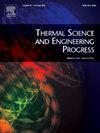池沸腾动力学的多模态方法:用于状态分类和热通量预测的声学和振动数据
IF 5.4
3区 工程技术
Q2 ENERGY & FUELS
引用次数: 0
摘要
本文提出了一种综合声学、振动和成像技术的多尺度池沸腾状态分类和热通量预测方法。池沸腾实验在钢丝加热器上进行,数据收集使用麦克风、加速度计和高速摄像机。对声学和振动数据进行了功率谱密度分析,揭示了与气泡动力学和热通量变化相关的不同频率响应。然后利用光谱功率分布对沸腾状态进行分类,确定从核沸腾到临界热通量(CHF)的过渡。采用适当的正交分解(POD)和动态模态分解(DMD)来关联沸腾频率并观察气泡的结构动力学。POD在第一种模式下捕获了超过98%的系统能量,而DMD在917.24 Hz和9799.12 Hz之间确定了重要的频率模式,突出了沸腾过程中的关键转变。然后使用简单的二叉决策树模型来评估声学和振动数据集在预测热通量方面的性能。模型的R2得分均在0.99以上。主成分分析(PCA)将声学和振动数据集的复杂性降低了97%以上,同时保留了99%的方差。结果表明,二叉决策树模型能够较好地预测热通量,且误差较小。该研究为沸腾状态的实时分类和热通量预测提供了一个框架,为池沸腾动力学提供了有价值的见解,并有助于安全热管理系统的开发。本文章由计算机程序翻译,如有差异,请以英文原文为准。

A multi-modal approach to pool boiling dynamics: Acoustic and vibration data for regime classification and heat flux prediction
This paper presents a multi-scale approach to pool boiling regime classification and heat flux prediction by integrating acoustic, vibration, and imaging techniques. Pool boiling experiments are conducted on a wire heater, and data is collected using microphones, accelerometers, and high-speed cameras. Power spectral density analysis is performed on the acoustic and vibration data, revealing distinct frequency responses that correlate with bubble dynamics and heat flux variations. The spectral power distribution is then used to classify the boiling regimes, identifying transitions from nucleate boiling to critical heat flux (CHF). Proper orthogonal decomposition (POD) and dynamic mode decomposition (DMD) are applied to correlate the boiling frequencies and observe the structural dynamics of the bubbles. POD captured over 98% of the system’s energy in the first mode, while DMD identified significant frequency modes between 917.24 Hz and 9799.12 Hz, highlighting key transitions in the boiling process. Simple binary decision tree models are then employed to evaluate the performance of both acoustic and vibration datasets in predicting heat fluxes. The models achieved R scores consistently above 0.99. Principal component analysis (PCA) reduced the complexity of the acoustic and vibration datasets by over 97% while retaining 99% of the variance. The results demonstrate that binary decision tree models are sufficient for predicting heat fluxes with relatively low error. This study provides a framework for real-time classification of boiling regimes and heat flux prediction, offering valuable insights into the dynamics of pool boiling and contributing to the development of safe thermal management systems.
求助全文
通过发布文献求助,成功后即可免费获取论文全文。
去求助
来源期刊

Thermal Science and Engineering Progress
Chemical Engineering-Fluid Flow and Transfer Processes
CiteScore
7.20
自引率
10.40%
发文量
327
审稿时长
41 days
期刊介绍:
Thermal Science and Engineering Progress (TSEP) publishes original, high-quality research articles that span activities ranging from fundamental scientific research and discussion of the more controversial thermodynamic theories, to developments in thermal engineering that are in many instances examples of the way scientists and engineers are addressing the challenges facing a growing population – smart cities and global warming – maximising thermodynamic efficiencies and minimising all heat losses. It is intended that these will be of current relevance and interest to industry, academia and other practitioners. It is evident that many specialised journals in thermal and, to some extent, in fluid disciplines tend to focus on topics that can be classified as fundamental in nature, or are ‘applied’ and near-market. Thermal Science and Engineering Progress will bridge the gap between these two areas, allowing authors to make an easy choice, should they or a journal editor feel that their papers are ‘out of scope’ when considering other journals. The range of topics covered by Thermal Science and Engineering Progress addresses the rapid rate of development being made in thermal transfer processes as they affect traditional fields, and important growth in the topical research areas of aerospace, thermal biological and medical systems, electronics and nano-technologies, renewable energy systems, food production (including agriculture), and the need to minimise man-made thermal impacts on climate change. Review articles on appropriate topics for TSEP are encouraged, although until TSEP is fully established, these will be limited in number. Before submitting such articles, please contact one of the Editors, or a member of the Editorial Advisory Board with an outline of your proposal and your expertise in the area of your review.
 求助内容:
求助内容: 应助结果提醒方式:
应助结果提醒方式:


